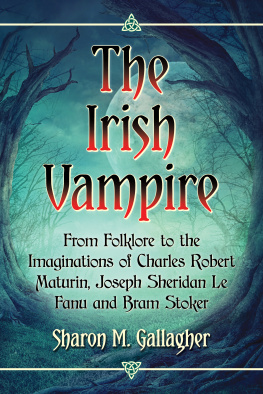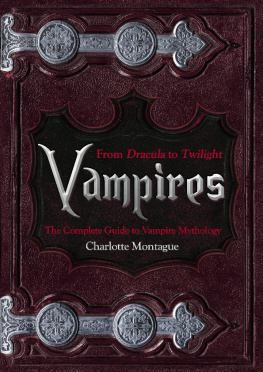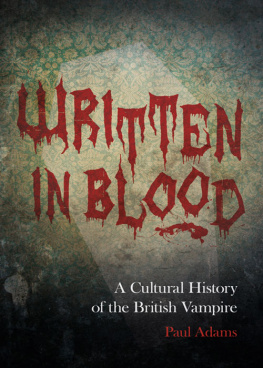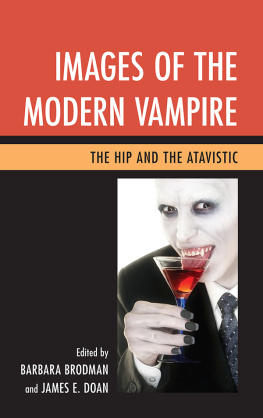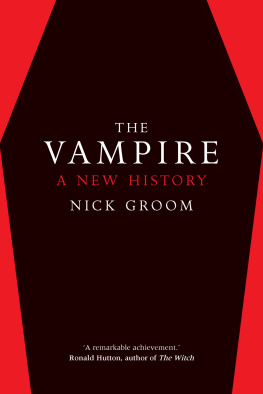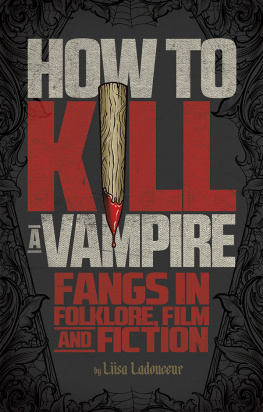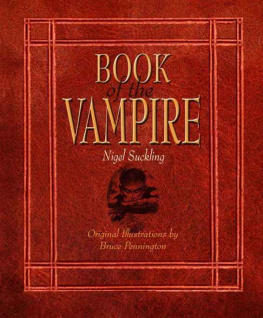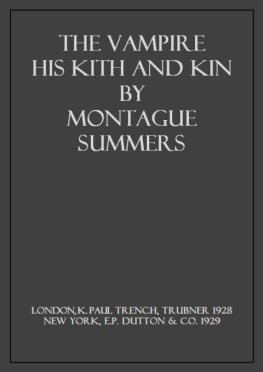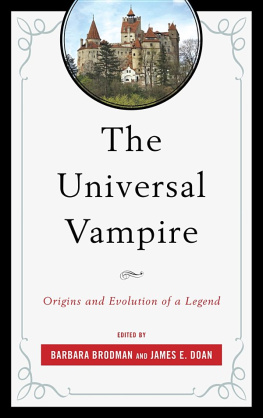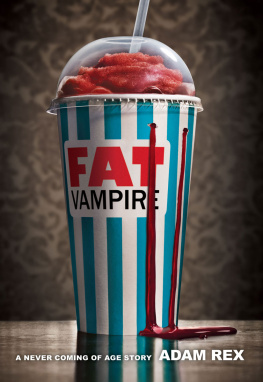
The Irish Vampire
From Folklore to the Imaginations of Charles Robert Maturin, Joseph Sheridan Le Fanu and Bram Stoker
SHARON M. GALLAGHER

McFarland & Company, Inc., Publishers
Jefferson, North Carolina
LIBRARY OF CONGRESS CATALOGUING DATA ARE AVAILABLE
BRITISH LIBRARY CATALOGUING DATA ARE AVAILABLE
e-ISBN: 978-1-4766-2796-0
2017 Sharon M. Gallagher. All rights reserved
No part of this book may be reproduced or transmitted in any form or by any means, electronic or mechanical, including photocopying or recording, or by any information storage and retrieval system, without permission in writing from the publisher.
Front cover images 2017 iStock
McFarland & Company, Inc., Publishers
Box 611, Jefferson, North Carolina 28640
www.mcfarlandpub.com
To my husband, Drew,
for all his support, patience, understanding,
and love throughout the entire process,
and
in memory of
Anthony C. Gallagher (19602004)
(You were right!)
Acknowledgments
So many people helped make this book possible that it would be difficult to list everyone, but there are some who must be named. First, my dissertation adviser, Dr. James Cahalan, who saw me through the long process from initial ideas to final manuscript. While the contents have been developed and expanded in the dozen years since my dissertation defense, this book would not have been possible without your guidance.
This extensive revision of my dissertation would not have been possible without the librarians at Penn State Behrend, Penn State Berks, and Penn State University Park campuses who were invaluable in their tireless efforts to find every odd text that I requested. A special thank you to Matthew Knight, Assistant Director of Special Collections, Assistant Librarian at the University of South Florida Libraries who provided me with a transcript of Dion Boucicaults rare 1852 play, The Vampire, A Phantasm. Also special thanks to Michael Osborne for allowing me to share his meticulous research on Charles Robert Maturins ancestors.
I want to thank Dr. Eric Corty at Penn State Behrend for recognizing that a non-tenure track faculty member like myself would greatly benefit if she had more time during the semester to work on this projectthe course release was greatly appreciated and well-utilized.
Of course, I am grateful for all my family and friends who supported me in a variety of ways as my dissertation evolved into this present text. I could not have done this without you and all your prayers, patient listening, and positive thoughts. Your faith in me and our faith in God has allowed me to realize one of my dreams.
Finally, I wish to thank all those who are cited in this textand there are a lot of you! Without all your hard work, this book would not have been possible.
Preface
The belief in the existence of vampyres is one of the most extraordinary and most revolting superstitions which ever disturbed the brains of any semi-barbarous people. It is the most frightful embodying of the principle of evil, the most terrific incarnation of the bad demon, which ignorance and fanaticism ever suggested to the weak and the deluded. It displays superstition in its grossest and most unrelieved horrors.
D, On Vampyrism, January 1823
Some years ago I set out to answer a single, seemingly limited questionwhat was the relationship, if any, between the bog bodies of Northern Europe and the vampires of the Slavsand blundered into an ambush of far more complicated and hostile questions.
Paul Barber, Vampires, Burial, and Death: Folklore and Reality, 1988
I readily empathize with Paul Barbers dilemma. In the late 1990s, after finishing my doctoral coursework and exams, I faced the problem of settling upon a topic for my dissertation. My broad area of study was nineteenth-century British literature, but my area of specific focus was Irish literature. I had a long-standing acquaintance with W. B. Yeats and the Irish Literary Renaissance; one of my graduate classes had featured Bram Stokers Dracula, which several of my fellow classmates were surprised to learn was written by an Irishman; and I was a huge fan of Joss Whedons Buffy the Vampire Slayer (19972003). Somehow these three unrelated facts converged into the idea that it would be innovative and original to argue that the modern vampire emerged from a nineteenth-century Irish literary tradition. Like Barber, my seemingly limited area of focus quickly proved to be otherwise. They say ignorance is bliss; my bliss lasted as long as it took me to walk to the library to begin the research for my working bibliography. It quickly became evident that other researchersmore knowledgeable, experienced, and publishedhad already not only delved into nineteenth-century Irish literature, Stoker, and the vampire, but there were many interesting facets to the topics, among which were two other earlier Irish authorsCharles Robert Maturin (17801824) and Joseph Sheridan Le Fanu (18141873)and the relatively new notion (then) of an Irish Gothic literature. Gothic literature was not a genre that had appeared in any titled course offerings in my undergraduate or graduate education, but its texts, like many of Edgar Allan Poes works and Mary Shelleys Frankenstein, were often required reading in some classes.
Fortunately, the reputation of Gothic literature and the vampire has changed in the professional arena. One need look no further than Patrick Brantlingers Rule of Darkness: British Literature and Imperialism, 18301914 (1988), Carol A. Senfs The Vampire in Nineteenth-Century English Literature (1988), Clive Leatherdales Dracula the Novel & the Legend: A Study of Bram Stokers Gothic Masterpiece (rev. 1993), Nina Auerbachs Our Vampires, Ourselves (1995), David Punters The Literature of Terror (1996), Fred Bottings Gothic (1996), Leonard Wolfs Dracula: The Connoisseurs Guide (1997), Richard Davenport-Hines Gothic: Four Hundred Years of Excess, Horror, Evil and Ruin (1998), A Companion to the Gothic (2000) edited by David Punter, Bruce A. McClellands Slayers and Their Vampires: A Cultural History of Killing the Dead (2006), Matthew Beresfords From Demons to Dracula: The Creation of the Modern Vampire Myth (2008), and The Universal Vampire: Origins and Evolution of a Legend (2013) edited by Barbara Brodman and James E. Doan to glimpse a few of the significant texts seriously examining the Gothic genre and the vampire. Not surprisingly, W. J. McCormacks Irish Gothic and After (1991), Margot Gayle Backuss The Gothic Family Romance: Heterosexuality, Child Sacrifice, and the Anglo-Irish Colonial Order (1999), Joseph Valentes Draculas Crypt: Bram Stoker, Irishness, and the Question of Blood (2002), The Irish Journal of Gothic and Horror Studies (first issue 2006), Richard Haslams Irish Gothic: A Rhetorical Hermeneutics Approach (2007), and Jarlath Killeens Gothic Ireland: Horror and the Irish Anglican Imagination in the Long Eighteenth Century (2005), Irish Gothic: A Theoretical Introduction (2006), and Irish Gothic Revisited (2008) have further focused on the subject of Irish Gothic and greatly enriched the discussion.
Killeens and Haslams publications particularly illustrate that the Irish Gothic is a dynamic subject area which offers many opportunities for discussion and debate. Killeens Irish Gothic: A Theoretical Introduction provides a useful overview of Irish Gothic criticism up to 2006 and, as he explains in his first paragraph, I will try to map the theoretical terrain covered by a number of these critics, and put forward a few hypotheses of my own which try to build on the insights already achieved. but also show ways in which the criticisms and their texts may be analyzed and debated. For the purposes of this study, the broader Irish Gothic will be used when discussing all three writers works rather than subcategorizing into either Protestant or Catholic.
Next page
